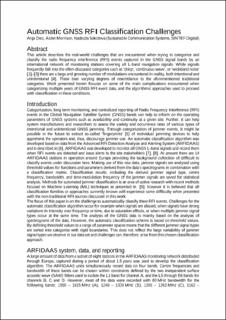| dc.contributor.author | Diez, Anja | |
| dc.contributor.author | Morrison, Aiden J | |
| dc.contributor.author | Sokolova, Nadezda | |
| dc.date.accessioned | 2023-03-03T12:06:19Z | |
| dc.date.available | 2023-03-03T12:06:19Z | |
| dc.date.created | 2022-09-12T14:08:54Z | |
| dc.date.issued | 2022 | |
| dc.identifier.citation | European Journal of Navigation. 2022, 22 (2), 12-21. | en_US |
| dc.identifier.issn | 1571-473X | |
| dc.identifier.uri | https://hdl.handle.net/11250/3055740 | |
| dc.description.abstract | This article describes the real-world challenges that are encountered when trying to automatically categorize and classify the radio frequency interference (RFI) events captured in the GNSS signal bands by an international network of monitoring stations covering all L-band navigation signals. While signals frequently fall into the often-discussed categories such as 'chirp', 'continuous wave', or 'wideband noise', there is a large and growing number of modulations encountered in reality, both intentional and unintentional. These bear varying degrees of resemblance to the aforementioned traditional categories. Work presented herein focuses on some of the main complications encountered when categorizing multiple years of GNSS RFI event data, and the algorithmic approaches used to proceed with classification in these conditions. | en_US |
| dc.language.iso | eng | en_US |
| dc.publisher | C&B Martens GbR | en_US |
| dc.title | Automatic GNSS RFI Classification Challenges | en_US |
| dc.type | Journal article | en_US |
| dc.description.version | publishedVersion | en_US |
| dc.source.pagenumber | 12-21 | en_US |
| dc.source.volume | 22 | en_US |
| dc.source.journal | European Journal of Navigation | en_US |
| dc.source.issue | 2 | en_US |
| dc.identifier.cristin | 2050861 | |
| dc.relation.project | Norges forskningsråd: 288634 | en_US |
| cristin.ispublished | true | |
| cristin.fulltext | preprint | |
| cristin.qualitycode | 1 | |
